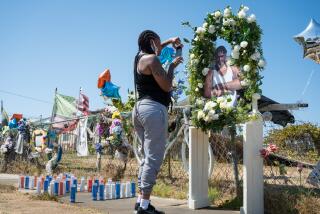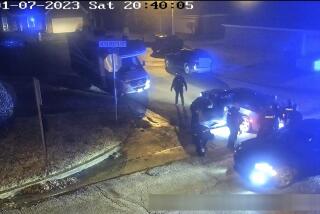Jurors View Videotape of Fatal Last Seconds
- Share via
In a darkened courtroom Thursday, a jury silently watched a videotape of the terrifying way that Debbie Ann Killelea met her death.
The tape was the central and final piece of evidence offered by the prosecution in the murder trial of Danny David Ornelas, 19, who fatally injured Killelea, 37, when he struck her with a car last Sept. 1.
The video shows Killelea in an alley behind the family’s home on East Ocean Boulevard on the Balboa Peninsula. Two of her children--sons Joe, 6, and Michael, 10--are seen standing by a wall in the 20-foot-wide alley. The boys appear to be calling to their mother, as if to warn her of danger. Killelea--who had often urged city officials to do something about fast traffic in the area--is shown standing near the center of the alley. She has her hands on her hips, in apparent disapproval of the car moving toward her. Abruptly she turns to run back to where her children are standing by the wall. And then the fuzzy pictures end in a jumble of scenes of walls and buildings. The video sound track, however, is distinct and heartbreaking. There is a keening, crying sound. One of Killelea’s sons is heard plaintively calling: “Where’s my mom? Where’s my mom?”
Killelea died of injuries a few hours after being struck by the fast-moving automobile that afternoon.
2nd-Degree Murder Charge
Ornelas, of Huntington Park, is being tried before Superior Court Judge Luis A. Cardenas in Westminster on a charge of second-degree murder.
The tape was accidentally made by John Lozano, 18, who was a passenger in the car.
The two young men had been on an outing to the beach and were driving on Balboa Peninsula at the time. Lozano testified earlier he that he had been playing with the video camera in the car and had accidentally turned it on during the trip up the alley.
The tape is the centerpiece of Deputy Dist. Atty. Thomas Goethals’ murder case against Ornelas. Goethals has said it clearly shows that Ornelas deliberately aimed the car at Killelea and kept after her. Goethals concluded the prosecution’s case Thursday with the dramatic screening.
Ornelas’ attorney, Ralph Bencangey of Beverly Hills, said the prosecution had failed to present evidence “beyond a reasonable doubt” that Ornelas is guilty of murder and asked Cardenas to dismiss the murder charge.
The videotape only proves that the collision was a tragic accident, not an intentional murder, Bencangey said. “If there were a crime committed in that alley, based on what has been presented to us, it would be manslaughter,” he told the judge.
Cardenas denied the motion, and the trial will continue Monday.
Bencangey said he will show next week that Ornelas was trying to avoid hitting Killelea.
“She was moving toward the center of the alley, and Danny responded by veering to the right to avoid her,” Bencangey said outside the courtroom. “Then she started to move back to the wall again and into the path of the car. She would have been safe if she had stayed by the wall and not moved into the center of the alley.”
The jury Thursday saw slowed-down frame-by-frame versions of the tape as well as the original one. The slower versions show Killelea’s actions more clearly, but the images are nonetheless fuzzy. The entire sequence in the alley lasts less than a minute.
Testimony on Blood Test
The jurors showed no emotion as they watched the various clips, and Ornelas sat impassively at the defendant’s table. Killelea’s husband and their three children have not attended the trial.
Martin Breen, of the Orange County Sheriff’s Department, who is an expert on drunk driving, testified Thursday that a blood test made Sept. 1 shortly after Ornelas was arrested showed a blood alcohol level of 0.18. According to state law, a level of 0.10 is evidence for presumption of drunk driving.
Breen also testified that his studies of drunk drivers show that they normally try to avoid hitting people or things “if they can see them.” His interpretation of the videotape, Breen said, was that Ornelas was driving the car toward rather than away from the woman as she tried to flee.
In cross-examination by Bencangey, Breen conceded that an argument could be made that Ornelas had veered to the right as Killelea moved to the center of the alley. “The key is when the driver implemented action relative to the motion of the object,” Breen said. “It depends on how the driver perceived it.”
Ornelas has said in interviews that he never intended to hit Killelea. He has been free since October on $100,000 bond.
Outside the courtroom Thursday afternoon, Bencangey declined to say whether he will put Ornelas on the witness stand next week. “That remains to be seen,” he said.
More to Read
Sign up for Essential California
The most important California stories and recommendations in your inbox every morning.
You may occasionally receive promotional content from the Los Angeles Times.













